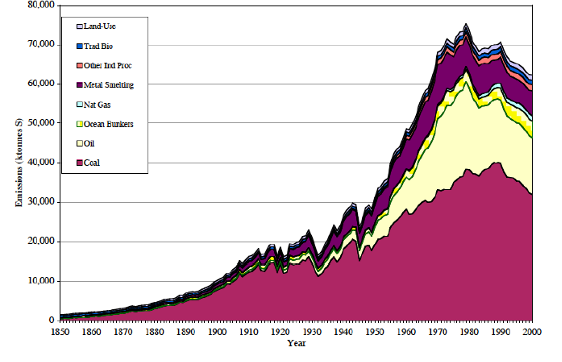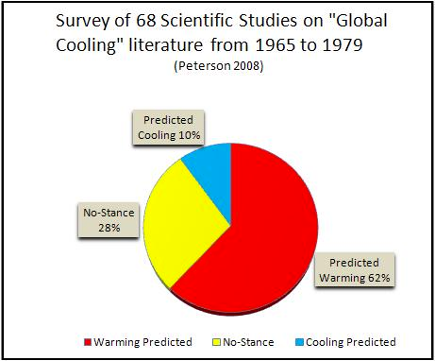What did 1970’s climate science actually say?
Posted on 12 November 2020 by morr6
This post is an updated intermediate rebuttal to the myth "scientists wrongly predicted an ice age in the 1970s so can't be trusted now". It was written by Margaret Orr as part of the George Mason University class Understanding and Responding to Climate Misinformation, combining climate science and communication best practices to debunk common climate myths.
In the 1970s, climate scientists were investigating the effects of rising industrial emissions on Earth’s climate. These emissions have two main components that affect the climate system. One of these components is carbon dioxide (CO2), a greenhouse or heat-trapping gas, that causes overall increases in global temperatures. The other component is aerosols, small atmospheric particles that block incoming sunlight. This can have a cooling effect on the Earth’s overall temperature, but aerosols only stay in the atmosphere for about two weeks before being rained out. These two contrasting effects led climate scientists to two different conclusions regarding what might happen to Earth’s climate in the future.
The Case for Cooling
Studies that projected aerosol-related cooling, such as Rasool and Schneider’s 1971 paper, said that “An increase by only a factor of 4 in global aerosol concentration may be sufficient to reduce surface temperature by as much as 3.5 K.” This speculation of quadrupling was based on the rapidly increasing concentration of aerosols like sulfur dioxide leading up to the 1970’s. However, with the adoption of policies like the Clean Air Act, aerosol emissions began to decrease in the late 1970’s. Figure 1 below from a 2004 paper shows this decrease in aerosol emissions. Note the peak in the late 1970s and the downslope since approximately 1980:

Figure1: Aerosol emissions from 1850-2000. Different colors of the graph indicate different sources of aerosols.
The Case for Warming
The warming effect of CO2 has been known since 1856, when scientist Eunice Foote published a study indicating that increasing atmospheric CO2 would increase the Earth’s overall temperature. A large majority (62%) of climate studies from the 1970s concluded that this greenhouse warming by CO2 was the dominant force of industrial emissions. In fact, there were 6 times more studies predicting warming than there were predicting cooling (Peterson et. al. 2008).

Figure 2: Percentages of peer-reviewed climate studies from 1965-1979 that predicted warming, the percentage that predicted cooling, and the percentage that took no stance on whether warming or cooling would occur.
So, what did 1970’s Climate Science Actually Say?
Despite the majority of studies projecting warming, one common myth today misrepresents climate science in the 1970s by saying that the general understanding was of an imminent ice age. The small fraction of studies predicting cooling received a lot of media attention in the 1970s. The idea of a forthcoming ice age made for great headlines. The effect of this disproportionate media coverage persists today, as some people and organizations continue to perpetuate the idea that an ice age was predicted in the 1970s.
Those who continue to spread this idea create a straw man argument. A straw man is when an opponent’s position is misrepresented in order to make that position easier to attack. In this case, the position is the cooling prediction that was only held by a small minority of scientists, and has since been abandoned. This straw man results in the distortion of public understanding of climate science, and made it easier to cast doubt on the fact that our planet is currently warming due to human activity.
Increased Scientific Understanding
The majority of climate scientists predicted warming from CO2 emissions, and data supporting this prediction increased throughout the 1970s. Many lines of evidence continued to build up, all indicating rising temperatures. By about 1980, evidence for warming was so overwhelming that ice age predictions had stopped altogether. This increase in understanding based on new evidence is a key part of the scientific process. Scientific thinking evolves as studies reveal new information. In the case of global warming vs. impending ice age, climatologist Stephen Schneider is an example of this key component of science. He was the second author on the aforementioned Rasool (1971) paper, which asserted that a quadrupling of aerosols would decrease global temperatures and, if this decrease was sustained, might lead into an ice age. However, upon revisiting this conclusion in 1974, when data and climate models had advanced, Schneider retracted the findings:
“I personally published what was wrong (with) my own original 1971 cooling hypothesis a few years later when more data and better models came along and further analysis showed [anthropogenic global warming] as the much more likely…” (Schneider quoted in Santer & Erlich 2014)
The prediction of cooling was based on the notion that aerosols from human emissions would quadruple. This increase simply did not happen, thanks in large part to actions like the Clean Air Act. Aerosol emissions actually decreased in the late 1970s, as previously mentioned. Thus, the key aspect of the cooling prediction did not come to pass, and the prediction was abandoned.
Today, observed warming of Earth’s average temperature continues to verify the majority predictions of climate scientists in the 1970s. Aside from the dominant planetary effect of CO2, a big reason that aerosols currently have a minimal effect on the climate is that actions have been taken to reduce aerosol emissions. We have a chance to create the same effect with greenhouse gases – by transitioning to renewables like wind and solar as our main energy sources. In doing so, we can decrease CO2 emissions and help curb the effects of warming global temperatures.































 Arguments
Arguments






























As any one will find out when dealing with 'hard core' deniers (as opposed to the gullible majority of 'sceptics'), who repeatedly post the same misinformation even after having been corrected multiple times, it's hard not to be driven to the conclusion that they are actually deliberately using deceit and insinuation to drive their readers to certain conclusions.
In this case the desired conclusion they want their audiences to jump to is that if scientists changed their mind once before, then it's unsafe to rely on what they are saying now, particulary about science based policy that is being planned to globally make big changes.
The insinuation and deceit is in how they frame their assertion. It uses a form of the 'magnified minority' technique (here's John Cook Tweeting about it twitter.com/johnfocook/status/1314301046756384794)
The misleader will say or write something like this
'but, but, but scientists predicted an ice age in the 70s - it was in Time and Newsweek - now they've changed their minds, so how can we trust them now?'
The thing about this deceit, like the best propaganda, is that it's technically true but rests upon the ambiguities of language to mislead.
The nitty gritty of the deceit is that the word "scientist's" can be taken to mean all scientists or as few as two. It gives no idea of the relative numbers, yet the insinuation in the 'imminent ice age' meme is that all, or the majority of, scientists supported the hypothesis.
The mention of the Time and Newsweek articles, which the public are infinitely more likely to remember and be far more familiar with than the consensus scientific view in the literature at the time, is highly likely to tip the undecided 'quantum state' of the public's appreciation of the topic towards their accepting that the scientific consensus back then was different to what it actually was...
For this MIT-graduate retired environmentalist who lived through the popular 1970s global cooling scare, there are several powerful lessons from that experience that are not addressed or debunked by this essay, or elsewhere on this site AFAICS. Among them the most troubling for motivating a political consensus for strong action now is probably the fact that the experts whose cooling fears were amplified by the press in the 70s (primarily Ehrlich, Holdren, and Schneider, according to my admittedly aging memory) seemed so convinced that lower average temperatures were strongly correlated with "scarier" and more deadly weather conditions, while the previous unusually warm period was unusually benign. Of course today's popular and press and political narrative justifying strong and urgent climate action is widely associated with the exact opposite correlation - that we have lived through a long period of unusually benign weather because it has been unusually cool, and that a relatively small amount of global average warming - too small for most "normal people" to notice as increased warmth - will necessarily bring a very significant increase in "scary" deadly weather conditions.
At least on the High School Science level on which most people and media and politicians (and striking students) seem to operate, there seems to be a choice between those two correlations: EITHER warm average temperatures are benign and falling temperatures threaten the world with scarier weather, OR cool temperatures are benign and rising temperatures threaten the world with scarier weather. But it seems unlikely that both are true.
I think it is also as true today as it was in the 70s that political action in the world's democracies is much more powerfully influenced by the press and politicians and the testimony of leading (=~ famous) scientists' sworn testimony to government committees than by the counting of peer-reviewed journal articles. Indeed, since virtually none of us is obviously capable of distinguishing between the roughly 50% of peer-reviewed articles that will eventually be proven false and the half that will be proven true, it seems that we must all rely heavily on the opinions of experts and "opinion leaders" on most complex policy issues.
Norm Rubin @2 Both an 'ice age' or unmitigated anthropogenic global warming would be dangerous for civilisation but in different ways. Our civilisation, and the ecosystems, agricultural zones etc we depend on 'evolved' and grew up due to the relatively stable temperatures we've had for 100s of thousands of years+.
Any significant departure from that 'Goldilocks zone' either way is likely to be very risky
Nick Palmer makes a some good points. I regulary come across the terminology "scientists say this" or "experts say this" in all sorts of discussions, and not just on climate. The terminology doesnt say some scientists say this or most scientists say this so its ambiguous. It doesnt lie by claiming all or most scientists say this when they dont, but the denialists are probably hoping it leaves the impression all or most scientists are saying this. Its a tactic regularly used by all sorts of lobby groups in my experience. They obviously dont want to get caught out in an obvious lie and get challenged or sued so they do the next best thing, they create an impression.
And thats the thing. I would say most of the hard core, regular denialists are linked to lobby groups and are quite unscrupulous in what they say for whatever reasons, perhaps because their pay cheque depends on it, or they are sociopaths or libertarian fanatics.
I agree it is not whether warm or cold climates are dangerous. They both cause problems. The real problem is a rapid shift to a new form of climate that is so fast adaptation becomes very difficult, perhaps impossible.
It is interesting to note the reduction in aerosols correlates to 1980 and beyond, as this is the area where warming effects, such as sea level rise, have accelerated. What I have noticed in reporting on climate (such as CSIRO state of the climate reports, 2010 to 2020) is the use of number of record temperature days, rather than warming per se, presumably to highlight the changes. I find this interesting, as that metric would seem to relate more to change in cloud cover, than radiative heat transfer caused by GHGs.